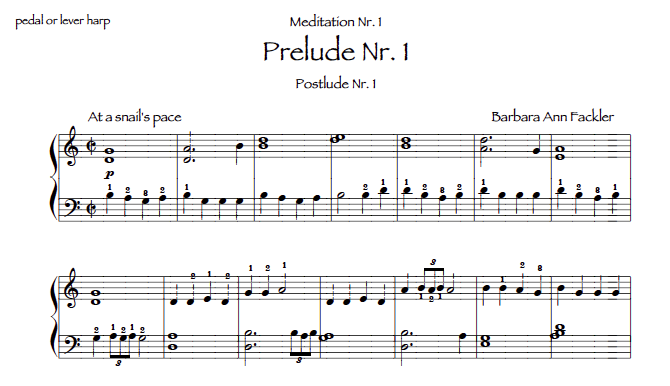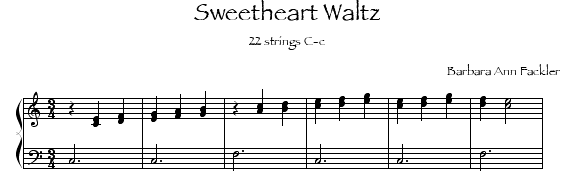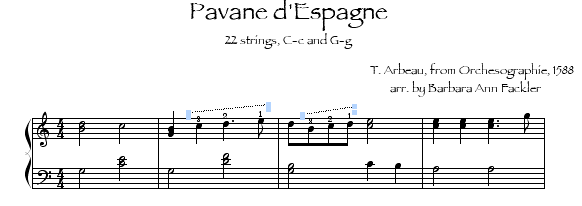

Each of these eight early solos will build skills within the context of performable music. If you've worked through the exercises found on our Free Tutorials page, then you should be able to master the songs in this collection, adding to your repertoire. The entire set (six original compositions, one Scottish tune, and one Renaissance dance) is suitable for 22 strings or more, no pedal changes, no lever changes, everything is in key of C.
Skills taught: note reading, the ability to place up to four fingers in a row, thirds, sixths, with some (optional) replacing and some glissandi.
1 ~ Felicitation- Focuses on finding the F and C strings to give a solid base in note reading. Some adult students, one of which named this piece, have used this for family weddings when they've been asked to perform as beginners.

2 ~ Irish Love Song (Eibhlin a Ruin or Eileen Aroon)- begins with LH and RH playing the same thing in octaves, then focuses on placing step wise groups, thirds. This is one of the traditional tunes that was performed (and collected by Edward Bunting) at the first Belfast Harp Festival in July of 1792. The melody is attributed to Carol O'Daly and has been recorded by the Clancy Brothers (1961) and Bob Dylan (1988). Shakespeare alludes to it in some of his plays. The words to the Scottish song "Robin Adair" have been set to this tune. Get the tutor to help you get started here (PDF).
3 ~ Meditation - Focuses on finding white strings on the staff, to furthur note reading skills while adding to repertoire with music appropriate for worship settings, therapeutic settings, recitals or just for fun. One melody is presented with simple accompaniment, once through with right hand playing the melody, followed by left hand playing the melody.
Oddlude Nr. 1 was based on this simple solo. The melody begins in the bass clef, then switching to the treble, the melody. The first sample below is THIS teaching piece. The second is the intermediate solo based upon it.


4 ~ Spring Song (includes tutorial) focus is on F & C strings, thirds, glissandi. This was composed for an adult student with MS who struggled with note reading, hence the focus on the colored strings.
Below you'll find the included tutorial for this piece, with theme played with both hands simultaneously. There are four simple variations, including the theme. Skill needed are ability to place (or willingness to learn) thirds and placing three and four notes in a row. Simple glissandi are included with no specific end note required.

5 Still Waters - this can be played with only 2nd finger if needed and is calm and meditative. It's great for therapeutic playing as well as appropriate for worship settings. Two pages, second page puts melody in left hand.

6 ~ Kelvingrove - This pleasant Scottish tune is used in the Gather book of worship as the tune for The Summons. There's plenty of practice in thirds and stepwise placing. This version is in the less common but easier to manage meter of 3/4 instead of the traditional version with lots of dotted rhythms. Both versions are included in the lead sheet collection of hymns. See image for suggested fingerings, click for larger image. midi generated sample mp3

7 ~ Sweetheart Waltz - reinforcing the skills of thirds, sixths and scales without watching hands: perfect for weddings or anniversary celebrations. You'll find this in the Accesible Solos collection, which is now free.

8 ~ Pavane d'Espagne - This stately Renaissance dance would have been used as a processional. No intervals larger than a third, good practice placing stepwise patterns. A more advanced version of this pavane is included on my CD, Pleasantries & Diversions. The lead sheet is included in the Harpsichore collection of lead sheets.

Still Waters, just the first half, with Were You There? as a middle section, to give you a push to make your own combinations (need more ideas, look at Simple Additions in our Resources section.
NEW ~ Candlestick Bransle (easy), Renassaince Dance tune - lever presets allow chromaticism to be included without lever changes within the piece. Download here.
NEW ~ Greensleeves - You'll need to have a start at learning root position chords, or be ready to learn. Download the easy Greensleeves for harp here. If you're new to root position triads (a chord of three notes), then go here as well and find the section called "Triads in Root Position" and get started.
NEW ~ Amazing Grace - Root position triads and thirds will serve you well in this arrangement.There's one 4 note chord - approach that by knowing that if you can play a root position triad, you can already find the top three notes, then "simply" add the 4th finger on the bottom note. A few fingerings are included.